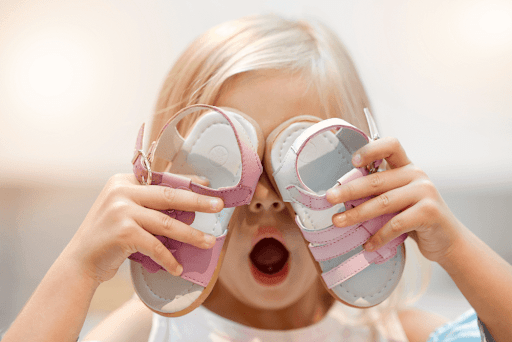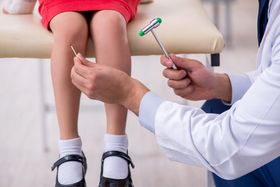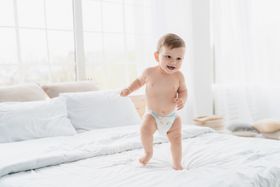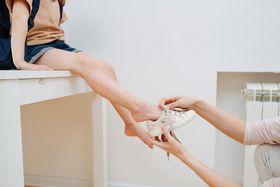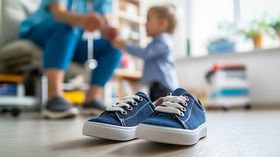Are Barefoot Shoes Really Good for Growing Toddlers?
The great shoe debate: Are barefoot shoes the key to healthy toddler feet, or a step in the wrong direction?
Published February 19, 2025.
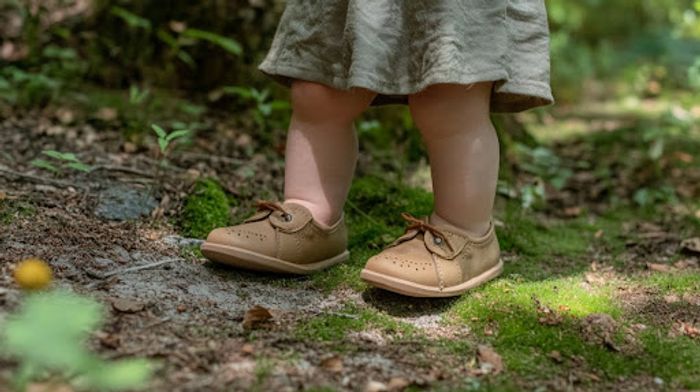
As parents, we're constantly bombarded with conflicting advice about what's best for our children's development. In footwear, barefoot shoes have gained significant attention in recent years. These minimalist shoes claim to support natural foot development, but are they suitable for your growing toddler?
Let's explore the evidence, benefits, and potential concerns to help you make an informed decision.
» Invest in their future. Find shoes that support natural foot development
What Are Barefoot Shoes?
Barefoot shoes are designed to mimic walking barefoot while still providing basic protection. Unlike conventional children's footwear, they feature several distinctive design elements:
- Wide Toe Box: This design allows toes to spread naturally, promoting healthy foot development, improving ground feel, and enhancing coordination. It also prevents restricted movement and potential toe deformities unlike tapered traditional shoes.
- Zero-Drop Sole: This sole maintains a level heel and forefoot, encouraging proper posture and weight distribution. This reduces stress on joints and promotes a more efficient gait, unlike raised heels in conventional shoes, which can alter gait mechanics.
- Thin, Flexible Sole: Enhances ground feel and proprioception, strengthening foot muscles and improving coordination. This contrasts with heavily cushioned shoes that diminish sensory input.
- Breathable, Lightweight Materials: Soft materials like leather conform to the foot, minimising pressure and irritation while allowing unrestricted movement. This reduces fatigue and promotes natural foot engagement.
- Non-Slip Natural Traction: This design provides grip on various surfaces without sacrificing flexibility. Unlike rigid, heavily treaded soles, it reduces slipping risk while preserving natural gait.
» Support your kid's development. Discover the benefits of orthopedic shoes
What Age Are Barefoot Shoes Aimed At?
Parents should consider introducing barefoot shoes when their child begins independent walking, typically between 12 and 18 months. This milestone marks when foot muscles, ligaments, and sensory pathways rapidly develop and need unrestricted movement for optimal growth.
Toddlers who walk barefoot or in barefoot-style shoes can develop stronger proprioception and improve strength, balance, and coordination. Traditional rigid shoes can interfere with natural foot mechanics, potentially weakening muscles and poor gait patterns.
Barefoot shoes can offer necessary protection while preserving the foot's natural function, supporting healthy arch development, stable posture, and long-term foot resilience.
» Read our parents' guide to helping your little one learn to walk
Are Barefoot Shoes Good for Kids?
For toddlers with no pre-existing foot conditions, barefoot shoes offer several significant benefits:
- Strengthening of Muscles: Toddlers' feet can move freely, activating the intrinsic foot muscles that support arch development and overall foot stability. Unlike rigid shoes that artificially support the foot, barefoot designs encourage active muscle engagement, preventing weakness and over-reliance on external support.
- Posture and Gait Development: The zero-drop sole allows toddlers to walk with a natural heel-to-toe motion and maintain proper body alignment. Stiff soles or elevated heels can alter movement patterns, creating compensatory postures that may impact the spine, hips, and knees.
- Proprioception and Sensory Feedback: The thin, flexible soles of barefoot shoes improve ground feel and help develop toddlers' proprioception. This increased sensory input enhances neural connections, improving reflexes, balance, and coordination.
- Balance and Toe Spread: The wide toe box lets toes spread naturally, promoting better stability and weight distribution. When toes are confined in narrow shoes, balance and coordination suffer. By allowing full-toe mobility, barefoot shoes facilitate a more stable stance and efficient walking mechanics, reducing the risk of falls and encouraging natural postural control.
» Worried about your kid's posture? Here's what you can do to fix it
Potential Challenges and Concerns
While barefoot shoes offer numerous advantages for toddler foot development, it's essential to be aware of potential challenges:
- Limited Cushioning on Hard Surfaces: Barefoot shoes can be uncomfortable on hard surfaces like concrete or asphalt. The thin soles offer minimal impact absorption, potentially leading to foot fatigue. For urban environments, consider shoes with more cushioning.
- Cold Weather Protection: The lightweight, breathable materials common in barefoot shoes may not provide enough insulation in cold or wet weather. Toddlers lose heat quickly, and cold exposure can affect comfort and circulation.
- Adaptation Period: Toddlers transitioning from traditional supportive shoes may experience an adjustment period. Their foot muscles might not be used to full engagement, causing temporary soreness or fatigue. Start with short periods of wear for a gradual transition.
- Traction: Although these shoes offer excellent ground feel, some may lack grip on smooth indoor surfaces like polished tile or hardwood. This can increase the risk of slipping, especially for toddlers still developing their coordination.
Who Should Not Wear Barefoot Shoes?
While barefoot shoes offer numerous benefits for foot development, they may not be ideal for all toddlers, especially those with certain foot conditions:
- Hypermobility: Kids with hypermobility (loose ligaments and less stable feet) might find the flexibility of barefoot shoes challenging. The lack of support could increase the risk of ankle rolling or poor gait mechanics.
- Underdeveloped Arches: Although these shoes can eventually strengthen foot muscles, toddlers with significantly underdeveloped arches may initially struggle. Prolonged use without any support could lead to discomfort, poor posture, and fatigue.
- Walking on Hard Surfaces: The minimal cushioning of barefoot shoes can cause discomfort and fatigue during long walks on concrete or asphalt. This is particularly important for developing feet. Minimally cushioned shoes might be more suitable for extended city outings, reserving barefoot shoes for softer, natural terrains.
- Cold or Wet Weather: The breathable, lightweight materials may not provide adequate insulation in cold or wet conditions. Toddlers are susceptible to temperature changes, and prolonged exposure to cold or damp surfaces can lead to discomfort and reduced circulation.
» Understand the best ways to treat kid growing pains
Making the Transition: Practical Tips
If you're considering barefoot shoes for your toddler, here are some steps for a successful transition:
- Start with short periods of indoor wear or on soft surfaces like grass or sand.
- Gradually increase wearing time as foot muscles strengthen.
- Watch for discomfort, excessive fatigue, or toe gripping.
- Allow barefoot time at home to strengthen and prepare feet before outdoor barefoot shoe use.
- Initially avoid extensive use on hard surfaces, instead choosing varied, softer terrain that encourages natural movement.
- Consider alternating between barefoot shoes and minimally supportive footwear to prevent overuse strain.
A Balanced Approach to Foot Health
Barefoot shoes can be an excellent choice for growing kids when introduced appropriately and used in suitable environments. They promote natural foot development, strengthen muscles, improve proprioception, and support healthy biomechanics.
However, they may not be ideal for all toddlers, particularly those with specific foot issues like hypermobility or on harsh urban surfaces or in cold weather. A balanced approach—using barefoot shoes while incorporating appropriate supportive footwear when necessary—ensures optimal foot development, comfort, and safety.
By understanding the benefits and limitations of barefoot shoes, parents can make informed choices supporting their toddler's unique developmental needs and active lifestyle.
» Give their feet the best of both worlds. Shop First Walkers now
Disclaimer: First Walkers' information is intended for educational and informational purposes related to toddler footwear and feet. We encourage you to consider individual circumstances and consult qualified orthopaedists about specific conditions.
